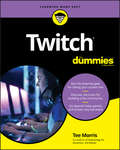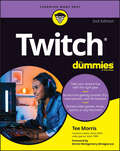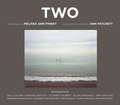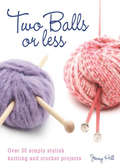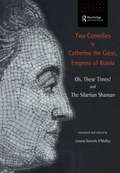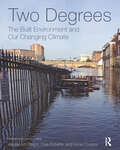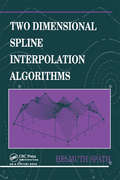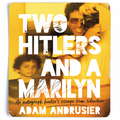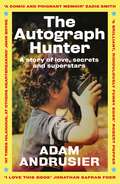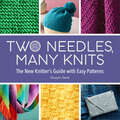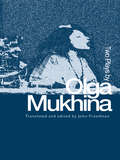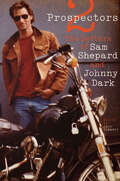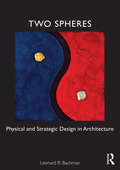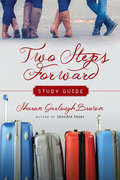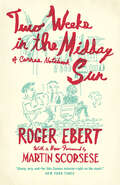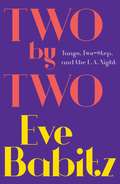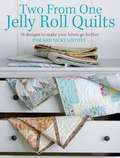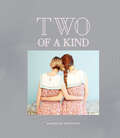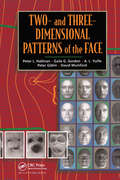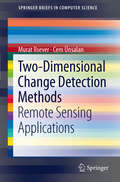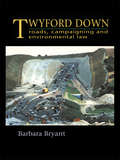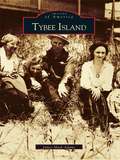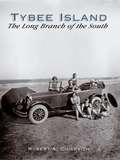- Table View
- List View
Twitch For Dummies
by Tee MorrisThe first full resource to offer advice on tapping into Twitch Twitch got its start as a live-streaming platform mostly populated by gamers and their fans. It's quickly grown to host streaming events of all kinds—concerts, conferences, production events like podcast recording sessions, and even pro sports. Twitch For Dummies helps initiate those new to streaming with advice on how to launch and build a Twitch channel. Podcasting For Dummies author Tee Morris guides readers through the basics of starting a channel, streaming games or live events, growing and interacting with an audience, and how to overcome common tech glitches. • Build a streaming studio • Create your Twitch profile • Find successful streaming strategies • Interact with your audience This guide offers friendly, reliable advice for broadcasters, marketers, and video fans on how to tap into the most popular online live-streaming service.
Twitch For Dummies
by Tee MorrisFind your own streaming success with Dummies Twitch For Dummies will get you up to date with Twitch, the breakthrough streaming platform where you can set up a channel, increase your viewership, and find your people. Step-by-step guides and helpful, real-life examples get you ready to go live and, who knows, maybe even earn a little money while having fun online. Check out this new edition for all the details on the new Creator Dashboard interface, streaming in the metaverse, and details you need to know to get the world watching. This handy reference even covers the latest Twitch integrations for streaming from your mobile devices. Community-based entertainment has never been hotter, and Dummies shows you how to get on board. Discover why the streaming platform Twitch is taking the world by storm Set up your first channel, stream gameplay, create highlight reels, and find viewers Understand the ad revenue structure so you can earn cash from your stream Get current on going live from the latest console models to Virtual Reality This is the perfect Dummies guide for new and established Twitch streamers who want to improve their audience and skills.
Two
by Melissa Ann PinneyA visual and literary exploration of the unique dynamic of twoTwo, a stunning collection of ninety images by award-winning photographer Melissa Ann Pinney, is a provocative, nuanced visual investigation of the relationship between two beings, whether they are relatives, friends, teammates, lovers, or strangers. With an introduction by bestselling novelist Ann Patchett, this beautiful volume contains exclusive literary contributions from ten of our finest contemporary writers on some aspect of two. Together, Pinney's powerful work and these extraordinary prose pieces present the multifaceted connection between beings that is at once wholly unique, yet universally understood.with contributions byBilly CollinsBarbara KingsolverEdwidge DanticatElizabeth McCrackenElizabeth GilbertMaile MeloyAllan GurganusSusan OrleanJane HamiltonRichard RussoWith more than ninety full-color photographs
Two Balls or Less
by Jenny HillDiscover how a little yarn can go a long, long way . . .Over 30 irresistible quick-to-stitch knitting and crochet projects celebrate the new generation of gorgeous gourmet yarns available to knitters and crocheters today. Say goodbye to old wool and humdrum cotton and hello to fun fleeces and fur, slinky twists of ribbon, luxurious lurex and bubble boucle. As you only need two balls, you can afford to experiment! Dedicated knitters can extend their skills by experimenting with crochet, whilst beginners will love the quick and simple designs for adults, kids, the home and gift occasions. Features useful tips and techniques to help you get the best from this exciting new generation of yarns.
Two Comedies by Catherine the Great, Empress of Russia: Oh, These Times! and The Siberian Shaman
by Lurana Donnels O'MalleyCatherine the Great (1729-1796) wrote over two dozen plays and operettas, but not until this edition has a complete translation of any of them been available to an English- speaking readership. Oh, These Times (1772) is a satirical attack on many vices Catherine wished to root out from her society: religious hypocrisy, superstition and slander. The main character, Mrs. Pious, is a superficially religious old woman who resembles Moliere's Tartuffe. Catherine again sets her sights on superstition in The Siberian Shaman (1786), this time by satirizing shamanism as a deceitful profession which preys on the gullible. This play was part of a group of three plays usually known as Catherine's "anti-masonic" trilogy, written as a warning against the growing influence of the freemasons. In a comprehensive introduction, Lurana Donnels O'Malley relates the plays to Catherine's status and philosophy.
Two Degrees: The Built Environment And Our Changing Climate
by Alisdair McGregor Cole Roberts Fiona CousinsThe Earth’s temperature has been rising. To limit catastrophic outcomes, the international scientific community has set a challenging goal of no more than two degrees Celsius (3.6 degrees Fahrenheit) average temperature rise. Economists agree we will save trillions of dollars by acting early. But how do we act successfully? And what’s the backup plan if we fall short? Setting politics aside, Two Degrees reviews the current science and explains how we can set practical steps to reduce the extent of warming and to adapt to the inevitable changes, all while improving the bottom line, beautifying our communities, and increasing human health. The book is a practical guide intended for a broad audience of those who occupy and shape our built environment. The authors provide a clear framework for communities, policy makers, planners, designers, developers, builders, and operators to help manage the impacts and capture the opportunities of our changing climate. Two Degrees is divided into three sections—Fundamentals, Mitigation, and Adaptation—covering a diverse array of topics ranging from climate-positive communities and low-carbon buildings to the psychology of choice and the cost of a low-carbon economy. After a foreword by Amory Lovins, more than 10 contributing authors share knowledge based on direct experience in all aspects of built environment practice. This book clarifies the misconceptions, provides new and unique insights, and shows how a better approach to the built environment can increase resilience and positively shape our future.
Two Dimensional Spline Interpolation Algorithms
by Helmuth SpäthThese volumes present a practical introduction to computing spline functions, the fundamental tools for fitting curves and surfaces in computer-aided deisgn (CAD) and computer graphics.
Two Hitlers and a Marilyn: An autograph hunter's escape from suburbia
by Adam Andrusier"I'd managed to puncture a hole between our universe and the parallel one where all the celebrities lived."'The zaniest book I've read in eons. Andrusier is a fresh new voice and more importantly he's funny as hell.'GARY SHTEYNGARTAdam Andrusier spent his childhood in pursuit of autographs. After writing to every famous person he could think of, from Frank Sinatra to Colonel Gaddafi, he soon jostled with the paparazzi at stage doors and came face-to-face with the most famous people on the planet.For young Adam, autographs were a backstage pass to a world beyond his chaotic family home in Pinner, and his Holocaust-obsessed father. They provided a special connection to a world of glamour and significance lying just beyond his reach.But as Adam turned from collector to dealer, learning how to spot a fake from the real deal, he discovered that in life, as in autographs, not everything is as it first appears. When your obsession is a search for the authentic, what happens when you discover fraudulence in your own family?Two Hitlers and a Marilyn is a hilarious and moving account of discovering that idols are mortals. It's a story of growing up, forgiveness and discovering a place in the world.'I love this book. It is wise, funny, surprising, touching, and wonderful company.'JONATHAN SAFRAN FOER(P)2021 Headline Publishing Group Limited
Two Hitlers and a Marilyn: An autograph hunter's escape from suburbia
by Adam Andrusier"I'd managed to puncture a hole between our universe and the parallel one where all the celebrities lived."'The zaniest book I've read in eons. Andrusier is a fresh new voice and more importantly he's funny as hell.' GARY SHTEYNGART Adam Andrusier spent his childhood in pursuit of autographs. After writing to every famous person he could think of, from Frank Sinatra to Colonel Gaddafi, he soon jostled with the paparazzi at stage doors and came face-to-face with the most famous people on the planet. For young Adam, autographs were a backstage pass to a world beyond his chaotic family home in Pinner, and his Holocaust-obsessed father. They provided a special connection to a world of glamour and significance lying just beyond his reach. But as Adam turned from collector to dealer, learning how to spot a fake from the real deal, he discovered that in life, as in autographs, not everything is as it first appears. When your obsession is a search for the authentic, what happens when you discover fraudulence in your own family? Two Hitlers and a Marilyn is a hilarious and moving account of discovering that idols are mortals. It's a story of growing up, forgiveness and discovering a place in the world.'I love this book. It is wise, funny, surprising, touching, and wonderful company.' JONATHAN SAFRAN FOER
Two Needles, Many Knits: The New Knitter's Guide with Easy Patterns
by Quayln StarkLearn how to knit—from a simple square to an entire sweater!"This valuable debut guide from Stark tells beginners all they need to know to get started knitting."— Publishers Weekly"This book's bright colors plus the ease of following Stark's instructions just might result in converts to the craft." — BooklistWondering where to start with knitting? Look no further! Two Needles, Many Knits is your one-stop-shop for knitting like a pro, with simple explanations of every essential technique and stitch. Once you master the basics, try out guided tutorials—complete with photos—for 15 knitting projects that put your new knowledge to use and help your skills and inspiration grow.Get to know your yarn—What's a purl stitch? Should you use acrylic or wool? How do you read a knitting pattern? Find the answers to the common knitting conundrums you might encounter.Expand your knitting know-how—This knitting book is divided into 3 skill levels, so you can practice at your own pace and knit your way from your first stitch to a complete garment.Projects you'll love—Create a Lapis Cinched Beanie, a Quartz Bias Scarf, or a Citrine Baby Basketweave Vest—the hardest part is deciding whether to give them as a gift or keep them for yourself!Discover how easy knitting can be with this ultimate all-in-one guide to knitting for beginners.
Two Plays by Olga Mukhina (Russian Theatre Archive Ser. #Vol. 18)
by John FreedmanOlga Mukhina is one of the most talented, young playwrights in Russia. Born in Moscow in 1970, she has already garnered enviable praise from critics and audiences throughout Russia and Europe since her first play, Tanya-Tanya, was performed in 1996. Tanya-Tanya is an atmospheric, poetic tale that observes three couples at a suburban Moscow home who dance, drink champagne, kiss, fall in and out of love, and struggle with dignity and humor to keep some semblance of control over their lives. The parallels with Chekhovian drama are undeniable and clearly intended by the author. You, Mukhina's most recent work, is a love poem to her hometown of Moscow as well as a scathing attack on the apathy of people blindly wrapped up in their own happiness and sorrow.
Two Prospectors: The Letters of Sam Shepard and Johnny Dark (Southwestern Writers Collection Series, Wittliff Collections at Texas State University)
by Sam Shepard Johnny DarkThis collection shares decades of correspondence between the Pulitzer Prize-winning playwright and one of his closest friends—including personal photos.One of America&’s leading dramatists, as well as an accomplished actor, screenwriter, and director, Sam Shepard&’s legacy includes immortal plays like True West and Buried Child, as well as memorable film roles, including his Academy Award-nominated performance in The Right Stuff. Though Shepard remained an intensely private man, he wrote candidly about his life and work in letters to his close friend Johnny Dark. His former father-in-law, Dark became a surrogate brother to Shepard, and even an artistic muse. Two Prospectors gathers nearly forty years of correspondence and transcribed conversations between them.In these letters, the men open themselves to each other with gripping honesty. Shepard&’s letters give us the deepest look we will ever get into his personal philosophy and creative process, while in Dark&’s letters we discover insights into Shepard&’s character that only an intimate friend could provide. The writers also reflect on the books and authors that stimulate their thinking, their relationships with women (including Shepard&’s anguished decision to leave his wife and son for actress Jessica Lange), personal struggles, and accumulating years. Illustrated with Dark&’s photographs of Shepard and their mutual family across many years, as well as facsimiles of numerous letters, Two Prospectors is a compelling portrait of a complex friendship that anchored both lives for decades, a friendship also poignantly captured in Treva Wurmfeld&’s film, Shepard & Dark.
Two Simple Shapes = 26 Crocheted Cardigans, Tops & Sweaters: If you can crochet a square and rectangle, you can make these easy-to-wear designs!
by Salena Baca&“These easy-to-follow instructions will have you hooking up a whole new wardrobe of beautiful, creative crochet pieces you will be proud to wear.&” —WeCrochet magazine Making crochet tops has never been so easy! Crocheted squares and rectangles can be shaped and combined to form a surprising array of pullovers, cardigans, lightweight tops, and wraps. Simple instructions will have you creating a variety of gorgeous crochet apparel. Most designs are beginner or intermediate level and build upon your knowledge of basic stitches to create textural styles that look more complex than they are. Crochet two squares to make the Diamond Crop Top, an on-trend lacy look you can whip up quickly, or crochet a rectangle, fold, and add sleeves to make the Goldenrod Cardigan, a squishy, comfy wrap to wear all year. Sumptuous yarns in gorgeous colors from Lion Brand&’s vast selection of yarns were chosen for the pattern samples shown in this book, assuring that all of the yarns used are easy-to-find, affordable options. Crochet in the colors shown, or try your own color scheme. Lion Brand yarns have a large selection of colors from which to choose, so enjoy the yarn aisle!
Two Spheres: Physical and Strategic Design in Architecture
by Leonard BachmanExplaining the connection between physical and strategic design, this book proposes an aesthetic connection between two equal aspects of architectural design: the Real and the Ideal. Addressing architectural thinkers from the broad realms of academia and practice, it is suitable either as a seminar text, a guide to contemporary design issues, or as a theoretical work. Beginning with a historical perspective, the book looks at some of the key conflicts in architectural thought that were brought about by postindustrial change. The discussion shifts to clearly describe the forms of complexity, how these have interacted with architecture and the possibilities in fully embracing complexity in architectural practice. Although there are many books focusing on complexity science, there are few that focus on the relationship between complexity and design and none which take such a comprehensive approach.
Two Steps Forward Study Guide (Sensible Shoes Series)
by Sharon Garlough BrownThe women of Sensible Shoes encounter new adventures and roadblocks in their spiritual journeys in Two Steps Forward. With this study guide, you can explore your own next steps as you dive into the book's spiritual formation themes along with Mara, Meg, Hannah, and Charissa. In this eight-week study guide you'll find daily Scripture readings, reflection questions, and spiritual practices designed to help you be attentive to the invitations of the Holy Spirit. Each week concludes with discussion questions and suggested practices for reading groups to do together. Individually or with a group, you are invited to meet with God and find encouragement for the path ahead.
Two Times Intro: On The Road With Patti Smith
by Michael Stipe"In Stipe’s startling photographs and 12 brief written homages, Patti Smith is depicted as a down-to-earth goddess, a part of and apart from her evolving entourage of musicians, artists, poets (Allen Ginsberg makes an appearance), and friends. This isn’t a traditional book of portraits . . . The overwhelming mood is one of disjunction, claustrophobia, exhaustion, temporariness--and the effect is raw and intimate . . . And [Stipe] is no longer the "dork nerd" teenager, but a fellow musician -- and from his proud, caring mien, even a protector."--Publishers Weekly"An energetic and gracious tribute to not only a great artist, but also to a powerful moment in her oeuvre -- and to those who contributed to it and shared in it."--New York Journal of Books"Stipe's personal friendship lends something greater to the overall vision of this book. It isn't simply a set of snapshots of performances, rather a collection of rare moments. The personal nature of the anthology makes it all the more enticing and enjoyable. Smith, in all her glory and awe-inspiring talent, is portrayed in the truest light."--Verbicide Magazine"A fascinating book . . . including appearances by Allen Ginsberg, Gregory Corso, Tom Verlaine, the members of Sonic Youth and more . . . and the short text tributes to Smith by these people, scattered throughout the manuscript, are well worth your time."--Chicago Center for Literature and PhotographyThis book comprises Michael Stipe's intimate and evocative photos of Patti Smith on tour in 1995, along with other cultural celebrities who appeared with her, such as Allen Ginsberg. In addition to text by Stipe, William Burroughs, and Patti Smith, there is also commentary from Thurston Moore, Kim Gordon, Lenny Kaye, Tom Verlaine, and more.Michael Stipe is a singer, photographer, film producer, and activist. He lives in Athens, GA, and New York, NY. R.E.M. formed in 1980 in Athens, GA, and is composed of Peter Buck, Mike Mills, and Michael Stipe. Heralded by Rolling Stone as "America's Best Rock and Roll Band," R.E.M. rose from cult college radio status to sell more than seventy million albums worldwide and was inducted into the Rock and Roll Hall of Fame in 2007.
Two Weeks in the Midday Sun: A Cannes Notebook
by Roger EbertA paragon of cinema criticism for decades, Roger Ebert—with his humor, sagacity, and no-nonsense thumb—achieved a renown unlikely ever to be equaled. His tireless commentary has been greatly missed since his death, but, thankfully, in addition to his mountains of daily reviews, Ebert also left behind a legacy of lyrical long-form writing. And with Two Weeks in the Midday Sun, we get a glimpse not only into Ebert the man, but also behind the scenes of one of the most glamorous and peculiar of cinematic rituals: the Cannes Film Festival. More about people than movies, this book is an intimate, quirky, and witty account of the parade of personalities attending the 1987 festival—Ebert’s twelfth, and the fortieth anniversary of the event. A wonderful raconteur with an excellent sense of pacing, Ebert presents lighthearted ruminations on his daily routine and computer troubles alongside more serious reflection on directors such as Fellini and Coppola, screenwriters like Charles Bukowski, actors such as Isabella Rossellini and John Malkovich, the very American press agent and social maverick Billy “Silver Dollar” Baxter, and the stylishly plunging necklines of yore. He also comments on the trajectory of the festival itself and the “enormous happiness” of sitting, anonymous and quiet, in an ordinary French café. And, of course, he talks movies. Illustrated with Ebert’s charming sketches of the festival and featuring both a new foreword by Martin Scorsese and a new postscript by Ebert about an eventful 1997 dinner with Scorsese at Cannes, Two Weeks in the Midday Sun is a small treasure, a window onto the mind of this connoisseur of criticism and satire, a man always so funny, so un-phony, so completely, unabashedly himself.
Two by Two: Tango, Two-Step, and the L.A. Night
by Eve BabitzA Simon & Schuster eBook. Simon & Schuster has a great book for every reader.
Two from One Jelly Roll Quilts
by Nicky Lintott Pam LintottThe basis of all the quilts in this book is just half a Jelly Roll! Each Jelly Roll makes two different quilt designs ? each made from twenty strips from the Jelly Roll. You will be delighted to find they get two quilts for the price of one ? how economical is that! The two designs from the same strip roll look totally different both in design and color. Each is described with step-by-step instructions and diagrams. You can cut your own twenty strips from your fabric stash, and you will find loads of inspiration for making a range of cot quilts, play-mats and wall hangings for your loved ones. Any of the designs can be adapted to make a larger quilt by referring to the vital statistics section, which contains all the required information and a few small calculations to make any size quilt you want.
Two of a Kind
by Sandrine KerfanteTwo of a Kind gathers images from photographers around the world in a striking celebration of visual symmetry. Twins, reflections, doubles, duplicates, and pairings are brought together in these dreamy images compiled by French photo curator and blogger Sandrine Kerfante. Fashion-forward, smart, and beautiful, this is the perfect gift for girlfriends with great taste who feel as close as sisters, actual sisters who feel as close as twins, and actual twins who will see their duality reflected in all kinds of intriguing new ways. A survey of 21st-century photography and an exploration of shared identity, this atmospheric collection, with metallic-tone and debossed cover, will transport its viewers, awakening the imagination and capturing the heart.
Two- and Three-Dimensional Patterns of the Face
by Peter W. Hallinan Gaile Gordon A. L. Yuille Peter Giblin David MumfordThe human face is perhaps the most familiar and easily recognized object in the world, yet both its three-dimensional shape and its two-dimensional images are complex and hard to characterize. This book develops the vocabulary of ridges and parabolic curves, of illumination eigenfaces and elastic warpings for describing the perceptually salient fea
Two-Dimensional Change Detection Methods
by Cem Ünsalan Murat IlseverChange detection using remotely sensed images has many applications, such as urban monitoring, land-cover change analysis, and disaster management. This work investigates two-dimensional change detection methods. The existing methods in the literature are grouped into four categories: pixel-based, transformation-based, texture analysis-based, and structure-based. In addition to testing existing methods, four new change detection methods are introduced: fuzzy logic-based, shadow detection-based, local feature-based, and bipartite graph matching-based. The latter two methods form the basis for a structural analysis of change detection. Three thresholding algorithms are compared, and their effects on the performance of change detection methods are measured. These tests on existing and novel change detection methods make use of a total of 35 panchromatic and multi-spectral Ikonos image sets. Quantitative test results and their interpretations are provided.
Twyford Down: Roads, campaigning and environmental law
by Barbara BryantThe Twyford Down story is set in a political and historical framework in order to examine the key issues affecting road planning and environmental protection: the system of route selection; Crown development; government agents, NGOs and locally elected authorities; conservation legislation; subsidiarity; lobbying techniques; and the role of the press. Written in a lively style and vividly illustrated, Twyford Down will appeal to environmental advisors, policy makers and planners as well as lobbyists and those interested in the environment.
Tybee Island (Images of America)
by James Mack AdamsTybee Island is a tiny piece of land, only-two-and-a-half miles long and two-thirds of a mile wide; however, its strategic location near the mouth of the Savannah River assigned to it an important role in the birth and history of the state of Georgia. Over this coastal community five flags have flown, representing Spain, France, England, the ConfederateStates of America, and the United States of America.Using numerous vintage photographs from the archives of the Tybee Island Historical Society, Tybee Island guides the reader through over two hundred years of history. Although much of its history is linked to nearby Savannah, Tybee is singular among Georgia's coastal islands, and has a history and lore that is uniquely its own. This visual journey begins with the building of Georgia's oldest and tallest lighthouse, and continues through Tybee's involvement in the Civil War. Also covered are the island's later roles as a military installation, apopular coastal resort, and a residential community. Vintage photographs recall earlier days on Tybee, when the island was known as "Ocean City," "Savannah Beach," and, to some, "the best kept secret on the East Coast."
Tybee Island: The Long Branch of the South
by Robert A. CiucevichFrom Guale Indians and Spanish explorers to its glory days as the queen of south Atlantic beach resorts and beyond, Tybee Island's quiet charm hides a rich and occasionally violent history. Soldiers, rebels, and rumrunners all found their place in history here as great battles, fires, and hurricanes played out over time. Through centuries of change, Tybee has remained one of the South's most popular resorts.
